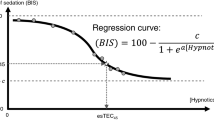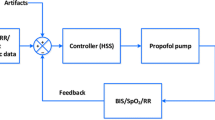Abstract
Purpose of Review
Automated control of anesthesia may give the physician time to control hemodynamics and supervise neurological outcomes and thus can provide the patient the safety and quality which until recently was considered a holy grail.
Recent Findings
This field of research is now increasing in every component of general anesthesia (hypnosis, nociception, neuromuscular blockade), and the literature describes some successful algorithms—single or multi-closed-loop controllers. These devices aim to control a predefined target and to continuously titrate anesthetics whatever the patients’ co-morbidities and surgical events to reach this target.
Summary
The literature contains many randomized trials comparing manual and automated anesthesia and shows the feasibility and safety of this system. Automation could quickly concern other aspects of anesthesia like fluid or vasopressor management. This review proposes an overview of closed-loop systems in anesthesia.

Similar content being viewed by others
References
Papers of particular interest, published recently, have been highlighted as: • Of importance
• Brogi E, Cyr S, Kazan R, Giunta F, Hemmerling TM. Clinical performance and safety of closed-loop systems: a systematic review and meta-analysis of randomized controlled trials. Anesth Analg. 2017;124:446–55. This meta-analysis written by specialists in automated anesthesia gives a good focus on the definitions and the goals to achieve with automated anesthesia compared to manual administration. The use of automated systems results in better control of a target within a selected range with a reduction of overshooting or undershooting. The authors described also the limits of the system.
Zorrilla-Vaca A, Healy RJ, Wu CL, Grant MC. Relation between bispectral index measurements of anesthetic depth and postoperative mortality: a meta-analysis of observational studies. Can J Anaesth. 2017;64:597–607.
Ruskin KJ, Corvin C, Rice S, Winter S. Autopilots in the operating room: safe use of automated medical technology. Anesthesiology. 2020;133:653–65.
Parasuraman R, Riley V. Humans and automation: use, misuse, disuse, abuse. Human Factors: J Human Factors Ergon Soc. 2016;39:230–53.
Brown EN, Lydic R, Schiff ND. General anesthesia, sleep, and coma. N Engl J Med. 2010;363:2638–50.
Glass PS. Automated control of anesthesia ten years later: futuristic novelty or present day reality. Can J Anaesth. 2010;57:715–9.
Gingras V, Rabasa-Lhoret R, Messier V, Ladouceur M, Legault L, Haidar A. Efficacy of dual-hormone artificial pancreas to alleviate the carbohydrate-counting burden of type 1 diabetes: a randomized crossover trial. Diabetes Metab. 2016;42:47–54.
Moore BL, Doufas AG, Pyeatt LD. Reinforcement learning: a novel method for optimal control of propofol-induced hypnosis. Anesth Analg. 2011;112:360–7.
Absalom AR, De Keyser R, Struys MM. Closed loop anesthesia: are we getting close to finding the holy grail? Anesth analg. 2011;112(3):516–8.
Kuck K, Johnson KB. The three laws of autonomous and closed-loop systems in anesthesia. Anesth Analg. 2017;124:377–80.
Liu N, Chazot T, Hamada S, Landais A, Boichut N, Dussaussoy C, et al. Closed-loop coadministration of propofol and remifentanil guided by bispectral index: a randomized multicenter study. Anesth analg. 2011;112:546–57.
Morley A, Derrick J, Mainland P, Lee BB, Short TG. Closed loop control of anaesthesia: an assessment of the bispectral index as the target of control. Anaesthesia. 2000;55:953–9.
Liu N, Chazot T, Trillat B, Pirracchio R, Law-Koune JD, Barvais L, et al. Feasibility of closed-loop titration of propofol guided by the Bispectral Index for general anaesthesia induction: a prospective randomized study. Eur J Anaesthesiol. 2006;23:465–9.
Dussaussoy C, Peres M, Jaoul V, Liu N, Chazot T, Picquet J, et al. Automated titration of propofol and remifentanil decreases the anesthesiologist’s workload during vascular or thoracic surgery: a randomized prospective study. J Clin Monit Comput. 2014;28:35–40.
Assenzo V, Assenzo C, Filippo R, Le Guen M, Sage E, Roux A, et al. The feasibility of extubation in the operating room after bilateral lung transplantation in adult emphysema patients: an observational retrospective study. Eur J Cardiothorac Surg. 2018;54:1128–33.
Biswas I, Mathew PJ, Singh RS, Puri GD. Evaluation of closed-loop anesthesia delivery for propofol anesthesia in pediatric cardiac surgery. Paediatr Anaesth. 2013;23:1145–52.
Orliaguet GA, Benabbes F, Chazot T, Glasman P, Fischler M, Liu N. Feasibility of closed-loop titration of propofol and remifentanil guided by the bispectral monitor in pediatric and adolescent patients: a prospective randomized study. Anesthesiology. 2015;122:759–67.
• Mahr N, Bouhake Y, Chopard G, Liu N, Boichut N, Chazot T, et al. Postoperative neurocognitive disorders after closed-loop versus manual target controlled-infusion of propofol and remifentanil in patients undergoing elective major noncardiac surgery: the randomized controlled postoperative cognitive dysfunction-electroencephalographic-guided anesthetic administration trial. Anesth Analg. 2021;133:837–47. This study is ancillary to a randomized control trial on automated versus standard anesthesia (induction and maintenance) but it introduced the relationship between general anesthesia and especially total IV anesthesia with systematic brain monitoring and the cerebral outcome. If it was previously supposed, this is the first confirmation with psychometric tests.
Liu N, Lory C, Assenzo V, Cocard V, Chazot T, Le Guen M, et al. Feasibility of closed-loop co-administration of propofol and remifentanil guided by the bispectral index in obese patients: a prospective cohort comparison. Br J Anaesth. 2015;114:605–14.
Joosten A. Anesthetic management using multiple closed-loop systems and delayed neurocognitive recovery: a randomized controlled trial. Anesthesiology. 2020;132:253–66.
Manohar M, Gupta B, Gupta L. Closed-loop monitoring by anesthesiologists — a comprehensive approach to patient monitoring during anesthesia. Korean J Anesthesiol. 2018;71:417–8.
Joosten A, Rinehart J, Van der Linden P, Alexander B, Penna C, De Montblanc J, et al. computer-assisted individualized hemodynamic management reduces intraoperative hypotension in intermediate- and high-risk surgery: a randomized controlled trial. Anesthesiology. 2021;135:258–72.
Stinson LW, Murray MJ, Jones KA, Assef SJ, Burke MJ, Behrens TL, et al. A computer-controlled, closed-loop infusion system for infusing muscle relaxants: its use during motor-evoked potential monitoring. J Cardiothorac Vasc Anesth. 1994;8(1):40–4.
Rinehart J, Liu N, Alexander B, Cannesson M. Review article: closed-loop systems in anesthesia: is there a potential for closed-loop fluid management and hemodynamic optimization? Anesth Analg. 2012;114(1):130–43.
Luginbuhl M, Bieniok C, Leibundgut D, Wymann R, Gentilini A, Schnider TW. Closed-loop control of mean arterial blood pressure during surgery with alfentanil: clinical evaluation of a novel model-based predictive controller. Anesthesiology. 2006;105(3):462–70.
Liu N, Chazot T, Hamada S, Landais A, Boichut N, Dussaussoy C, et al. Closed-loop coadministration of propofol and remifentanil guided by bispectral index: a randomized multicenter study. Anesth Analg. 2011;112(3):546–57.
Meijer F, Honing M, Roor T, Toet S, Calis P, Olofsen E, et al. Reduced postoperative pain using nociception level-guided fentanyl dosing during sevoflurane anaesthesia: a randomised controlled trial. Br J Anaesth. 2020;125:1070–8.
Phan TD, Ismail H, Heriot AG, Ho KM. Improving perioperative outcomes: fluid optimization with the esophageal Doppler monitor, a metaanalysis and review. J Am Coll Surg. 2008;207:935–41.
Lilot M, et al. Comparison of cardiac output optimization with an automated closed-loop goal-directed fluid therapy versus non standardized manual fluid administration during elective abdominal surgery: first prospective randomized controlled trial. J Clin Monit Comput. 2018;32:993–1003.
Snider EJ, et al. An automated hardware-in-loop testbed for evaluating hemorrhagic shock resuscitation controllers. Bioengineering (Basel). 2022;9(8):373.
Snider EJ, et al. Evaluation of a proportional-integral-derivative controller for hemorrhage resuscitation using a hardware-in-loop test platform. J Pers Med. 2022;12:979.
Rinehart J, et al. Closed-loop control of vasopressor administration in patients undergoing cardiac revascularization surgery. J Cardiothorac Vasc Anesth. 2020;34:3081–5.
Ngan Kee WD, et al. Closed-loop feedback computer-controlled phenylephrine for maintenance of blood pressure during spinal anesthesia for cesarean delivery: a randomized trial comparing automated boluses versus infusion. Anesth Analg. 2017;125:117–23.
Libert N, et al. Performance of closed-loop resuscitation of haemorrhagic shock with fluid alone or in combination with norepinephrine: an experimental study. Ann Intensive Care. 2018;8:89.
Hemmerling TM, Arbeid E, Wehbe M, Cyr S, Taddei R, Zaouter C. Evaluation of a novel closed-loop total intravenous anaesthesia drug delivery system: a randomized controlled trial. Br J Anaesth. 2013;110:1031–9.
Puri GD, Mathew PJ, Biswas I, et al. A multicenter evaluation of a closed-loop anesthesia delivery system: a randomized controlled trial. Anesth Analg. 2016;122:106–14.
Pasin L, Nardelli P, Pintaudi M, et al. Closed-loop delivery systems versus manually controlled administration of total IV anesthesia: a meta-analysis of randomized clinical trials. Anesth Analg. 2017;124:456–64.
Cotoia A, Mirabella L, Beck R, et al. Effects of closed-loop intravenous anesthesia guided by bispectral index in adult patients on emergence delirium: a randomized controlled study. Minerva Anestesiol. 2018;84:437–46.
Dumont GA. Feedback control for clinicians. J Clin Monit Comput. 2014;28:5–11.
Mccormick PJ, Levin MA, Lin HM, et al. Effectiveness of an electronic alert for hypotension and low bispectral index on 90-day postoperative mortality: a prospective, randomized trial. Anesthesiology. 2016;125:1113–20.
Dumans-Nizard V, Hamada S, Fischler M. Bispectral index during cardiopulmonary resuscitation: a poor indicator of recovery. Two very different cases. Anaesthesia. 2010;65(2):196–8.
Le Guen M, Liu N, Tounou F, Auge M, Tuil O, Chazot T, et al. Dexmedetomidine reduces propofol and remifentanil requirements during bispectral index-guided closed-loop anesthesia: a double-blind, placebo-controlled trial. Anesth Analg. 2014;118(5):946–55.
Liu N, Chazot T, Trillat B, Michel-Cherqui M, Marandon JY, Law-Koune JD, et al. Closed-loop control of consciousness during lung transplantation: an observational study. J Cardiothorac Vasc Anesth. 2008;22:611–5.
Author information
Authors and Affiliations
Corresponding author
Ethics declarations
Conflict of Interest
Dr. Le Guen: none.
Drs Liu is the inventor and co-owner of a patent for a gain constant and control algorithm for a closed-loop anesthesia management system. He is a co-founder of MedSteer, a biomedical company that promotes research and development in closed-loop anesthesia devices.
Dr. Jean Selim: none.
Human and Animal Rights and Informed Consent
This article does not contain any studies with human or animal subjects performed by any of the authors.
Additional information
Publisher's Note
Springer Nature remains neutral with regard to jurisdictional claims in published maps and institutional affiliations.
Rights and permissions
Springer Nature or its licensor (e.g. a society or other partner) holds exclusive rights to this article under a publishing agreement with the author(s) or other rightsholder(s); author self-archiving of the accepted manuscript version of this article is solely governed by the terms of such publishing agreement and applicable law.
About this article
Cite this article
Le Guen, M., Liu, N. & Selim, J. Computer-Assisted IV Anesthesia: Still a Future?. Curr Anesthesiol Rep 13, 187–195 (2023). https://doi.org/10.1007/s40140-023-00568-y
Accepted:
Published:
Issue Date:
DOI: https://doi.org/10.1007/s40140-023-00568-y




